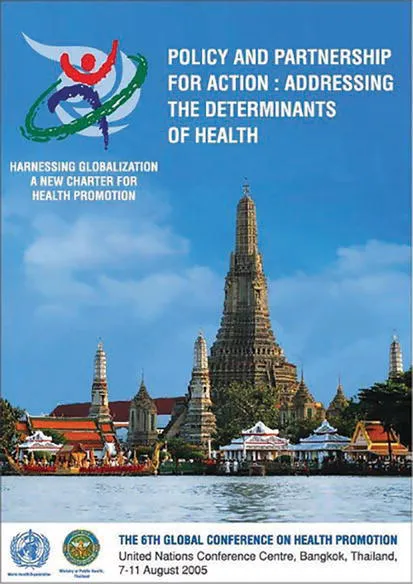![]()
1 The Foundations of Health Promotion
RUTH CROSS, SIMON ROWLANDS AND SALLY FOSTER1
This chapter aims to:
• explore concepts of ‘health’ held by lay people and health promoters;
• introduce recent work on the social determinants of health;
• introduce certain threshold concepts including salutogenesis, social models of health and upstream thinking;
• establish the value base of health promotion;
• introduce the disciplinary foundations of health promotion
• outline in more detail ‘empowerment’ as a key value in health promotion; and
• describe the key WHO conferences, which provide the milestones in the development of health promotion.
The aim of this chapter is to provide an orientation to current thinking in health promotion and offer some of the material that would be covered in an introductory module, laying the foundations for a course of study. It is essential to understand that health promotion is a political and ethical activity, with a sound value base providing the platform for practice and setting its direction.
Our view of health promotion is that it is a social movement with the central aim of tackling the social determinants of health and so bringing about greater social and health justice. By the ‘social determinants of health’ we mean those factors that enable people to live healthy and productive lives – these factors include the obvious ones of decent housing, access to education, employment opportunities, nourishing food, well-functioning and accessible health care, cohesive communities, good systems of government and peaceful, safe nation-states. The social determinants of health can either enable people and communities to flourish and do well, or not, depending on whether (or how) they create opportunities for better health. Social justice is harder to define, and is often used interchangeably with related concepts such as ‘fairness’, ‘equality’ and ‘equity’. Aristotle’s Ethics suggest that equity is where like but different individuals are both regarded and treated justly because they are equally valued. Thus, regardless of ability/disability, gender, sexual orientation, ethnicity, age or any other variable that differentiates people, all individuals have equal value. Treating individuals with equal value is just and therefore contributes to social justice. Logically, following from this is the idea that ‘social goods’ such as health should be distributed fairly. Harvey (1973, p. 98), in his attempt to outline the ‘skeleton concept’ of social justice, says that it starts with a ‘just distribution justly arrived at’. We can argue that where access to a good, decent and productive life is not available to some, where some live in abject poverty and others in excessive wealth, then there is clearly not ‘a just distribution’. This raises the question of whether people have the right to good health, and we would assert that people do indeed have the right to those determinants that produce good health. This is enshrined in the Universal Declaration of Human Rights: that people have the right to the conditions necessary to achieve the highest possible standard of health (United Nations, 1948; Marks, 2004). This rights-based approach to health was strongly reiterated in the 2030 Agenda for Sustainable Development and Universal Health Coverage (WHO, 2017). Health promotion has, at its heart, the drive to eliminate health inequities, if inequity means the failure to regard and treat ‘like but different’ individuals and groups justly because they are not equally valued.
Individual readers might pause at this point and think that they do indeed see all individuals as having equal worth. However, we can clearly see that at a global scale we do not treat individuals as having equal worth – otherwise children would not be dying in the ‘developing’ world due to preventable diseases such as diarrhoea, respiratory infections or measles, whilst others live in unimaginable luxury. There would not be the less dramatic differences between individuals within the same country, such as in England, with children growing up in situations described as below the poverty line (for a ‘developed’ country) and those living in very comfortable wealth. Inequities in health experience and outcomes are being highlighted at the time of updating this chapter amid the Covid-19 pandemic (April 2020). Ratcliffe (2020) points out how the pandemic is emphasizing existing inequality and disproportionately affecting certain groups of people, despite the rhetoric that ‘we are all in this together’ – see Box 1.1 for further elaboration.
Box 1.1. Health inequity and Covid-19 in England (April, 2020).
‘What is interesting about the risk of death (from Covid-19) is that it almost perfectly tracks your current risk of death. So, if you are already sick, from a BAME background, grew up in poverty or are already older you are more likely to develop serious symptoms and/or die. The economic impacts will be most acutely felt by those with the fewest resources: people in low paid jobs, people who have chronic mental of physical illness, people on temporary or “zero hours” contracts and those who are living from pay check to pay check. It is also likely that those in low paid manual jobs (e.g. [working in] supermarkets, social care, construction etc.) will be less able to socially distance by working from home and, hence, less able to minimise the risk of infection. Those who are confined to home in poor quality or cramped housing will have the most miserable experience and those living in the least affluent, vibrant and green surroundings will suffer the biggest fall in wellbeing. These individuals are all part of the same group: the poorest in society. […] Covid-19 has taken the social determinants of health, which have been insidiously working away behind the scenes, slowly eroding peoples’ health and wellbeing, and exploded their impact into full view’ (Ratcliffe, 2020, www.fairhealth.org.uk).
This central concern with health equity has been present since the Ottawa Charter, and was present in the World Health Organization (WHO) from 1946. According to Whitehead and Dahlgren (2007, p. 5), health equity
… implies that ideally everyone could attain their full health potential and that no one should be disadvantaged from achieving this potential because of their social position or other socially determined circumstance. This refers to everyone and not just to a particularly disadvantaged segment of the population. Efforts to promote social equity in health are therefore aimed at creating opportunities and removing barriers to achieving the health potential of all people. It involves the fair distribution of resources needed for health, fair access to the opportunities available, and fairness in the support offered to people when ill.
The outcome of these efforts would be a gradual reduction of all systematic differences in health between different socioeconomic groups. The ultimate vision is the elimination of such inequities, by levelling up to the health of the most advantaged.
The concern with health inequities culminated in the global health promotion community cohering behind the work of the Commission on Social Determinants of Health (CSDH). The Commission was established by the WHO in 2005 and chaired by Sir Michael Marmot. It was essentially an independent enquiry into the social and environmental issues affecting health and planned to investigate actions with the potential to promote greater health equity that has been referred to as a ‘global blue-print for the health promotion community and the stakeholders we work with’ (Chapter 6.) Outlining a vision for 2040, she quotes the Charter of the People’s Health Movement:
Equity, ecologically-sustainable development and peace are at the heart of our vision of a better world – a world in which a healthy life for all is a reality; a world that respects, appreciates and celebrates all life and diversity; a world that enables the flowering of people’s talents and abilities to enrich each other; a world in which people’s voices guide the decisions that shape our lives.
(Baum, 2009, p. 73)
Addressing the social determinants of health.
This captures part of what health promotion is all about – that is, the wish to envision what kind of world we want to create – for ourselves and for future generations. Envisioning the future has been a central activity of health promotion since its inception at the Ottawa conference in 1986. The Ottawa Charter, coming up to its 35th anniversary, remains a central document for anyone studying health promotion. It is the cornerstone of the modern health promotion movement. Its value lies in its outline of strategies and activities to achieve health for all. Whereas ‘Health for All by the Year 2000’ was a call to mobilize governments, the Ottawa Charter is more of a guide to how to go about putting the vision into practice.
The central concern with the social determinants of health is what distinguishes health promotion from public health. Health promotion takes a different approach from ‘mainstream’ public health, and we suggest that health promotion is more a form of politics than a part of the medical enterprise – that it is more allied to social policy than it is a profession allied to medicine. The politicized nature of health promotion is captured nicely by Larsen and Manderson (2009) when they write that health promotion is about:
… representing marginalized populations, advocating equity, giving voice to the powerless and educating people in civic rights, democracy and politics, that is, in citizenship. In this respect, health promotion represents a humanist discourse aimed at creating a more equal and just society.
(Larsen and Manderson, 2009, p. 608)
More will be said on citizenship in subsequent chapters.
Employment – a social determinant of health (from Creative Commons source: Work is Going on by cogdogblog is licensed under CC0 1.0).
That we do not live in an equal and just society is easy to demonstrate. Data on inequalities in health abound, whether this is within rich countries such as the UK, between richer countries, such as the USA and Japan, or in poorer countries of the global South. The reasons for the existence of these inequalities are more contentious. Wilkinson and Pickett (2009) claim to have produced an undeniable argument that inequalities in health within countries are explained by inequalities in wealth, not by the absolute wealth of that country, and that the more unequal a society, the more inequalities in health there are in that society. As epidemiologists who have worked on health inequalities, they show the socially corrosive impacts of inequality, and how ‘almost everything – from life expectancy to mental illness, violence to illiteracy – is affected not by how healthy a society is, but how equal it is’ (2009, back cover). The Spirit Level (Wilkinson and Pickett, 2009) received a great deal of attention and also criticism; however, since its publication the evidence of a causal relationship between inequalities and health outcomes is actually more robust than ever (see, for example, Pickett and Wilkinson, 2015; Bambra, 2016). The Black Report of 1980 was the first major report in the UK to highlight how health is systematically related to social class, and it put forward a number of reasons for this. L...


